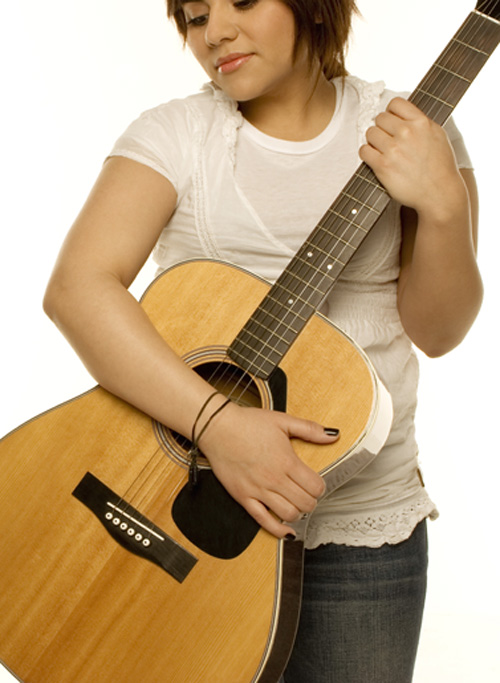

Stop 3b - A Few Absolute Basics Before You Go Too Far
Here are a few things you should know as you begin playing the guitar...
1. Learn the Names of the Strings
Whether you're learning to read or not, to get anywhere on the guitar you have to learn the names of the strings. That means, first, what notes each of them is tuned to.
For instance you must know that string 1 (the thinnest) and string 6 (the thickest) are both tuned to E. String 1 is referred to as High E, and string 6 is referred to as Low E.
But especially if you're learning to read. In order to enhance and accelerate your music reading you should know where you can find each of the open strings on the staff. If you're not sure, check out this Open String exercise and learn this stuff cold.
2. Fingering Hand Technique
Your fingering hand (left hand for righties)
Think "classic position": with your fingers spread out over the first four frets, one finger per fret. Try not to move you hand a lot as you finger different fret positions. Discipline yourself to use finger one on fret one, finger two on fret two, finger three on fret three, and finger 4 (your pinky) on fret 4. Use these same fingers across the different strings. For example when playing A3 use finger 3, when playing G2 use finger 2, and so on.
Press down on the string behind and as close to the appropriate fret as you can to get a nice clean sound. At first the notes will probably sound muddy and weak. Just keep working on it and it will eventually start to sound better.
3. Picking Hand Technique
Your picking hand (right hand for righties)
Assuming you're using a pick, hold it between your thumb and forefinger resting on your (slightly tucked) middle finger as pictured here:

The pick is usually aligned, more or less, with the forefinger, and the tip of the pick protrudes roughly 1/4″ beyond the fingers.
This allows you to keep your hand fairly close to the strings, and makes it easy to control the movement of the pick. If too much of the pick protrudes from the fingers it becomes difficult to be precise with your picking action. Anchoring your picking hand.This is a matter of personal preference, but many guitar players will anchor their picking hand somewhere on the body of the guitar to make it easier to control the picking motion.
As you can see in the accompanying picture (illustrating how to hold the pick), the lower part of the hand can be anchored on the bridge (depending on what sort of guitar you are using). Another common way is to is to use you bottom two fingers stretched out and resting below the strings.
5. Alternate the Picking Direction
You won't appreciate this right at the beginning, but every guitar instructor will tell you to "use alternate picking". Say you're playing 4 notes one after the other. Alternate picking means play note 1 with a down stroke and note 2 with an up stroke; note 3 with a down stroke, and note 4 with an upstroke.
The reason for this is quite simple. It is more efficient and faster to use a combination of up and down strokes rather than all down strokes as you would just naturally do.
Try to be fairly religious about this. You will eventually learn that alternate picking may not be appropriate in every case, but it will be good to get into the habit very early on. You can make adjustments when you feel more at home on the instrument.
6. Systematic Practice Makes Perfect
It goes without saying that you cannot get better if you don't practice. But it is important to recognize that some practice times will be more productive than others. Here are some suggestions:
- Don't be closed minded. Keep your options open - listen to a variety of music and be open to different styles: e.g., rock, pop, folk, country, etc.
- Find a teaching resource (teacher, online lessons, instructional book) that is suitable to your level of development, and overall objectives.
- Practice songs you like, but also practice more generic skills such as scales, arpeggios, learning to read, alternate chord shapes, etc.
- Play along with practice tracks to give you an idea of how you can do in a group.
- Jam with friends. Create a band. Have fun.